What Is an IT Roadmap? Complete Guide (2025)
Learn the purpose of an IT roadmap, how it guides infrastructure and software planning, and tips for developing one.

Growing a young business means making choices that shape how your technology supports the rest of the company. Founders, product managers and design‑oriented leaders often ask what is an IT roadmap because they are pulled in many directions and need a common plan. Without clear guidance, teams add tools and infrastructure on an ad‑hoc basis and end up with fragile systems, poor communication and wasted effort. In this article I’ll share how experienced product and design leaders think about technology planning, why a roadmap matters and how to build one that stays flexible. We will talk about strategy, components, building steps, examples and answer frequent questions.
What is an IT Roadmap?
An IT roadmap is a strategic planning tool that outlines both near‑term and longer‑term technology initiatives. It acts like a blueprint for how technical teams will support a company’s vision by describing milestones, phases and major decisions. Whatfix explains that an IT roadmap "visually outlines short‑ and long‑term technology initiatives" and acts as a blueprint for how IT will support business goals. Such a plan shows where you are and where you want to go, providing clarity for everyone from engineers and designers to executives.
The term itself comes from the world of hardware and software planning. As Sarah Gibbons at Nielsen Norman Group notes, Motorola introduced the "technology‑roadmap process" in 1987. This process spread through hardware and software firms in the early 1990s as a way to prioritise and communicate upcoming work. A roadmap differs from a technical backlog or release plan because it focuses on strategic objectives and time horizons rather than granular tasks.
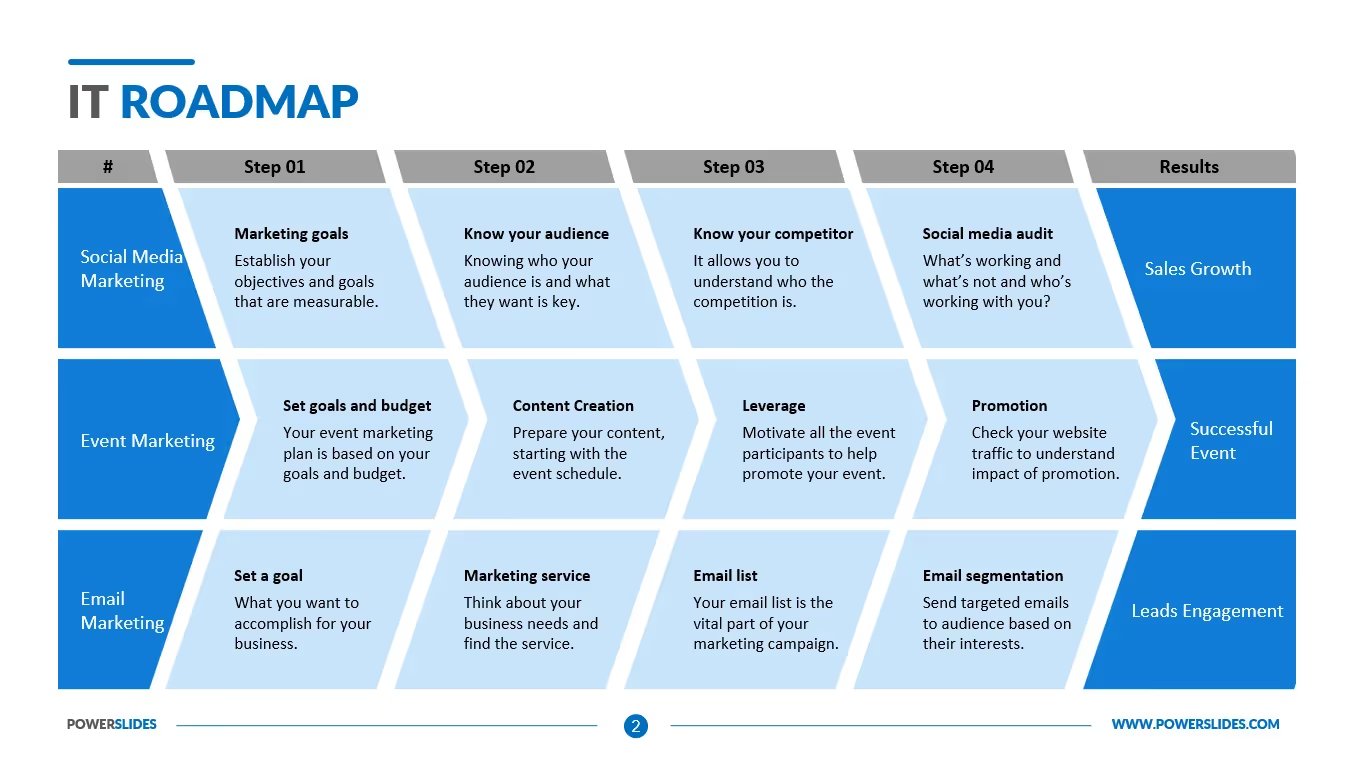
How it differs from related concepts
An IT roadmap is distinct from other planning tools. It is not the same as a general technology strategy, which describes the guiding principles for technology decisions. A technology roadmap focuses on initiatives and timing rather than philosophy. It also differs from a product roadmap. Product roadmaps share the future direction of a product with customers and stakeholders. According to the Institute of Product Leadership, a product roadmap guides strategic product decisions and features, whereas a technology roadmap outlines the investments needed to achieve those product goals. Whatfix points out that product roadmaps are often shared externally to set expectations about features, while IT roadmaps are internal documents focused on supporting the organisation’s broader goals.

Who uses it and why it matters
Technology roadmaps serve different audiences. Founders and executives use them to match technology spending with company objectives and manage risk. Product managers and design leads rely on them to make sure that user experience improvements are supported by the right infrastructure. Engineering teams use them to prioritise technical debt and plan upgrades. A well‑structured roadmap helps with business alignment: it ties technical initiatives to outcomes such as revenue growth or operational efficiency. For early stage startups, this helps avoid waste. Without a roadmap, teams may invest in tools that do not scale, or delay essential upgrades until they become urgent and costly.
The data support this. Ntiva’s 2024 report notes that by the end of 2025 global spending on tech transformation is expected to hit 3.4 trillion dollars. With such large investments at stake, clarity on where to focus resources matters. The same report highlights that 85 percent of executives rank technology transformation as a priority and that cybercrime is expected to cost the world 10.5 trillion dollars annually. Without a clear plan, companies risk pouring money into tools that neither improve security nor support their mission.
Key Components and Types of IT Roadmaps
Components and building blocks
Roadmaps differ in format, but good ones share a common set of elements. Think of these as building blocks you assemble into a visual plan:
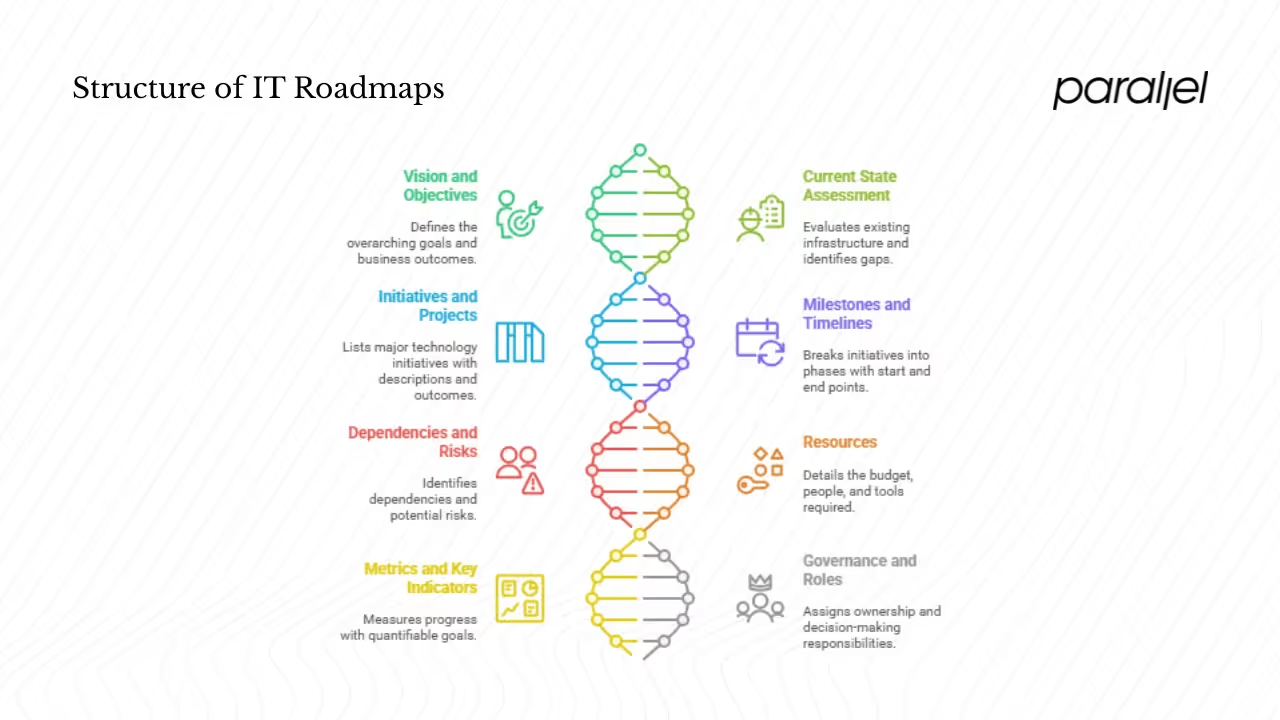
- Vision and objectives: Clearly define the business outcomes the roadmap supports. These could include improving product delivery speed, reaching new markets or strengthening security. A high‑level vision anchors all initiatives.
- Current state assessment: Conduct an honest review of the existing infrastructure, software stack, processes and tech debt. This baseline helps you identify gaps. For example, are your databases scaling properly? Do your design systems support accessibility? Without this assessment you risk planning initiatives on unstable ground.
- Initiatives and projects: List the major technology initiatives needed to achieve your objectives. Each initiative should include a short description, the problem it addresses and the expected outcome.
- Milestones and timelines: Break initiatives into phases with start and end points. Timelines provide structure while leaving room for adaptation. Whatfix emphasises that roadmaps highlight critical milestones and specific technology solutions to be adopted over time.
- Dependencies and risks: Identify which initiatives depend on others and note risks such as vendor lock‑in or regulatory changes. Documenting dependencies helps teams coordinate and adjust when priorities shift.
- Resources: Detail the budget, people and tools required for each initiative. Include cross‑functional roles like product, design and finance to ensure broad ownership.
- Metrics and key indicators: Decide how you will measure progress. Typical metrics include system uptime, performance, user adoption, cost savings or time to market. Ntiva suggests setting quantifiable goals, such as reducing security incidents by 20 percent or improving ticket resolution times.
- Governance and roles: Assign ownership. Roadmaps need a steward who updates the plan and coordinates reviews. Include decision points for when to revisit priorities.
Types of IT roadmaps
Before choosing a format, think back to what is an IT roadmap in your situation. Roadmaps come in various styles, and the right type depends on your audience and purpose:
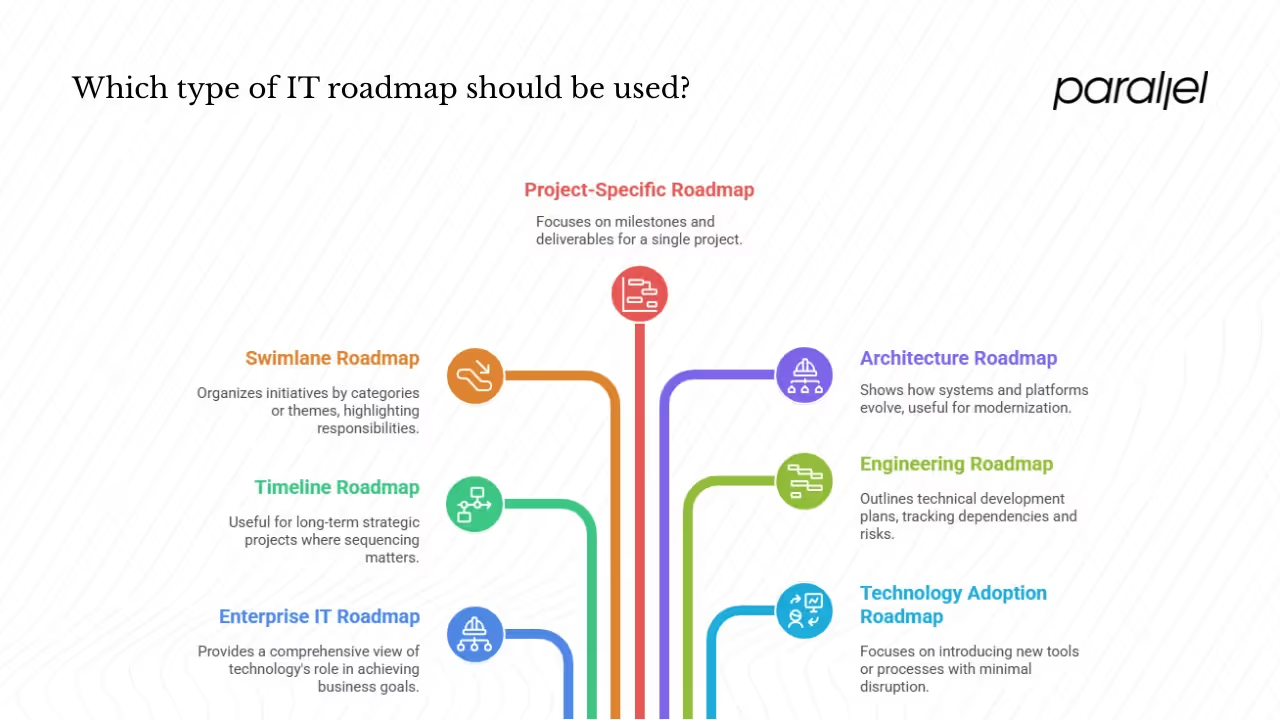
- Enterprise IT roadmap: A high‑level plan that spans the entire organisation and links major projects like system integration, compliance and change management. Whatfix notes that an enterprise IT roadmap provides a comprehensive view of technology’s role in achieving business goals.
- Timeline roadmap: Uses a horizontal axis to show when key projects start and end. It is useful for long‑term strategic projects where sequencing matters.
- Swimlane roadmap: Organises initiatives by categories or themes rather than strict timelines. Each lane represents a team or focus area, making dependencies clear and highlighting who is responsible.
- Project‑specific roadmap: Focuses on one project or a cluster of related projects. It highlights milestones, deliverables and key dates.
- Architecture roadmap: Shows how systems and platforms evolve. It is particularly useful for legacy modernisation.
- Engineering roadmap: Outlines the technical development plan for building software or hardware. Engineering teams use it to track dependencies, sprints and technical risks.
- Technology adoption/change management roadmap: Focuses on introducing new tools or processes while minimising disruption. It often pairs with training and communication plans.
These types are not mutually exclusive. For example, an early‑stage startup might use a swimlane roadmap to coordinate product, design and infrastructure work and an architecture roadmap to plan migration to a new platform. The point is to choose the format that communicates effectively to your audience.
How to Create an IT Roadmap – Step‑by‑Step Guide
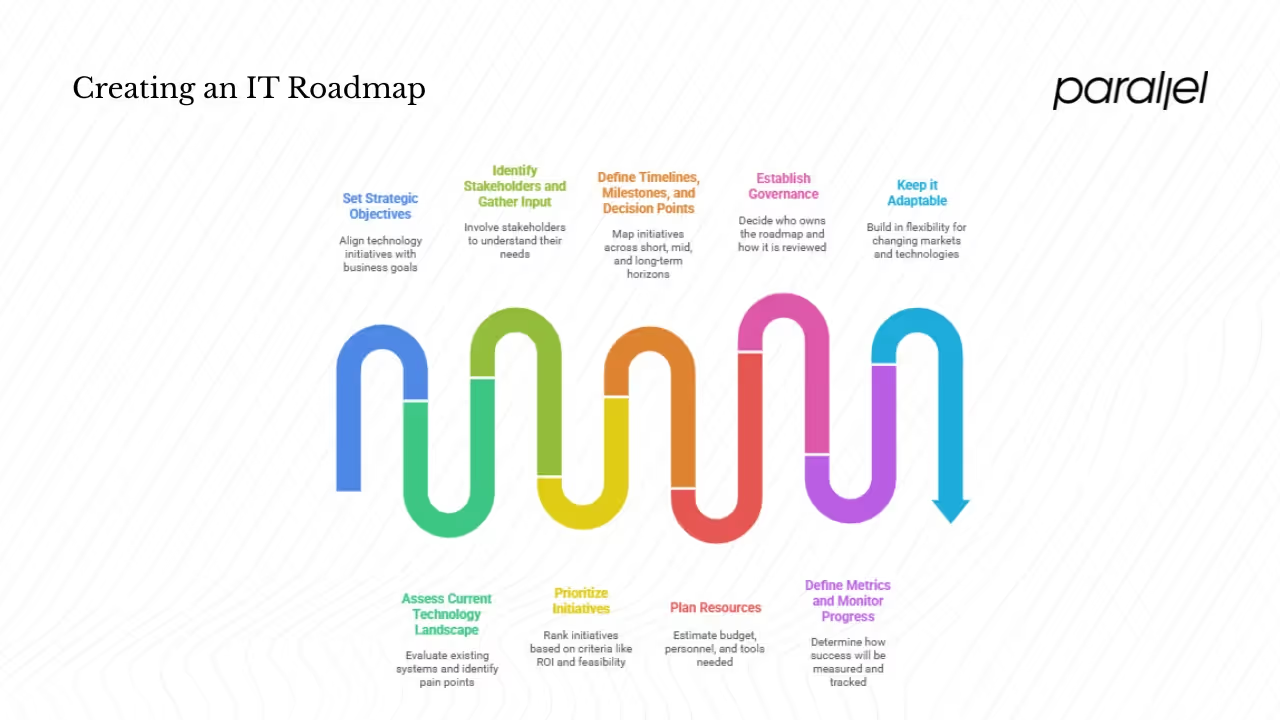
1. Set strategic objectives
Start by linking your technology initiatives to clear business goals. As part of strategic planning, identify how technology will support growth, customer satisfaction or operational efficiency. For instance, if you are aiming to double user adoption in the next year, list the infrastructure, security and design improvements necessary to support increased traffic. In our experience at Parallel, early stage AI‑driven SaaS teams often overcomplicate their onboarding flows. We focus on what improvements directly reduce time to value. Setting clear objectives helps avoid chasing every trend.
2. Assess the current technology landscape
Once objectives are set, perform an honest assessment of your existing systems. Evaluate your software stack, hosting, databases, integrations, and design systems. Document tech debt and pain points. Ask teams: Where are the bottlenecks? Which tools are difficult to maintain? According to the Ntiva guide, reviewing the past year’s technology investments helps identify what delivered value and what did not. This review allows you to learn from experience before planning new investments.
3. Identify stakeholders and gather input
Many founders ask about their technology plan when they start gathering stakeholders because they know that the plan must reflect shared priorities. A roadmap is a collaborative effort. Include executives, technical leads, product managers, designers, operations, finance and sometimes key customers. Different perspectives surface hidden constraints and opportunities. Interview these stakeholders to understand their pain points and constraints. For example, designers may need better prototyping tools, while finance may be concerned about licensing costs. Involving all voices reduces the risk of siloed decisions.
4. Prioritise initiatives
After collecting possible initiatives, rank them. Prioritisation criteria can include return on investment, risk, feasibility, urgency and resource availability. At Parallel, we often group initiatives into themes: foundational (e.g., security upgrades), growth (e.g., self‑serve analytics), and differentiators (e.g., AI‑driven personalisation). Use a simple matrix to weigh benefit versus effort. This helps cut through wish lists and focus on what delivers the most value.
5. Define timelines, milestones and decision points
Map initiatives across short‑term (0–6 months), mid‑term (6–18 months) and long‑term horizons. A timeline roadmap is helpful here. Remember to include decision points—moments when you will reassess based on new information. Given how quickly markets change, roadmaps need to remain flexible. Whatfix emphasises that a roadmap plots a path forward while remaining adaptable to evolving technology.
6. Plan resources
Estimate the budget, people and tools needed for each initiative. Early stage companies often underestimate the staffing needed to maintain new systems. Include external partners if you plan to bring in consultants. Resource planning also covers training; new tools may require upskilling your team. Ntiva suggests setting quantifiable goals and budgeting for them, such as reducing security incidents or downtime.
7. Establish governance
Decide who owns the roadmap and how often it is reviewed. Assign a cross‑functional steering group that includes representation from technology, product and design. Define how changes will be proposed and approved. Having a governance model helps prevent the roadmap from being ignored or constantly changing without oversight.
8. Define metrics and monitor progress
Determine how success will be measured. Good metrics answer whether the initiative moved the needle towards your objectives. Examples include system uptime, deployment frequency, cost per transaction or customer satisfaction scores. Regularly check progress and share updates with stakeholders. Using metrics builds accountability and facilitates course corrections.
9. Keep it adaptable
Markets and technologies shift. Build in flexibility by scheduling periodic reviews and allowing initiatives to be re‑prioritised. This approach mirrors agile product development—learning and adjusting rather than sticking rigidly to an outdated plan. The Ntiva report reminds us that trends like AI and cloud technologies are accelerating, so roadmaps must be able to respond.
Best Practices and Common Pitfalls
Best practices
- Keep it simple and visual: Use diagrams, timelines or swimlanes to communicate the plan. Avoid cluttering slides with dense text.
- Tailor to your audience: Executives need to see the business case and high‑level timing, while engineers appreciate more detail on dependencies. Provide different views of the same roadmap rather than one overstuffed chart.
- Use realistic data for estimates: Base your timelines and budgets on historical data or benchmarks. Overly optimistic plans lead to frustration and erode trust.
- Maintain transparency: Share the roadmap widely and invite feedback. Transparency encourages accountability and helps stakeholders understand trade‑offs.
- Review and update regularly: Schedule periodic reviews—quarterly or bi‑annually—to adjust to new information. Document changes and communicate why they were made.
Common pitfalls to avoid
- Over‑ambitious planning: Trying to do too much at once leads to burnout and delays. Be honest about your capacity and pick a manageable number of initiatives.
- Ignoring technical debt: Failing to address legacy issues can cause future failures. Balance new features with infrastructure improvements.
- Limited stakeholder involvement: Building a roadmap in isolation leads to misaligned expectations. Engage all relevant teams early and often.
- Rigid timelines: Treat the roadmap as a living document. Rigid schedules are unrealistic in a fast‑changing environment.
- Lack of metrics: Without clear metrics, it is impossible to know whether an initiative succeeded. Define success criteria before starting.
Examples, Case Studies and Templates
- Enterprise view: Use a three‑horizon timeline that groups initiatives under themes like security, product enablement and operations. Each column represents now, next and later. This format is similar to the UX roadmap structure described by Nielsen Norman Group, where themes are placed into "Now", "Next" and "Future" horizons.
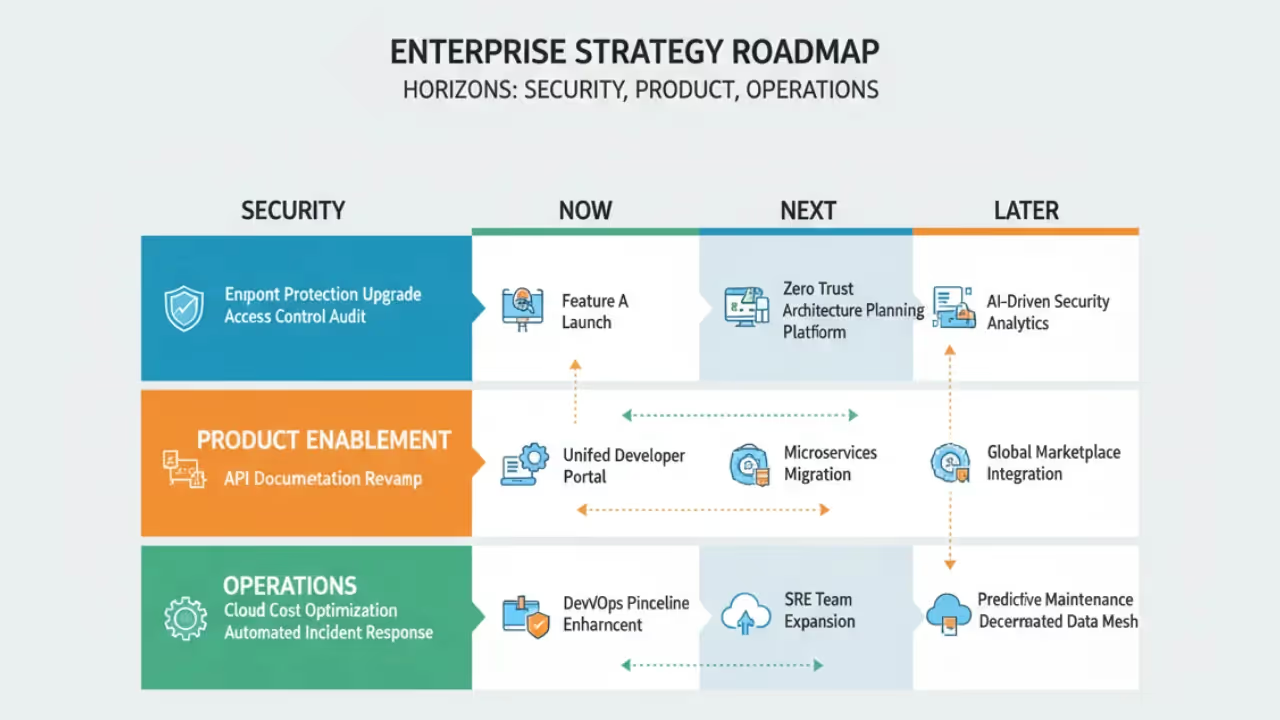
- Swimlane view: Create horizontal lanes for design, engineering, product and operations. Within each lane, list initiatives without specific dates. This visual makes dependencies across teams obvious.
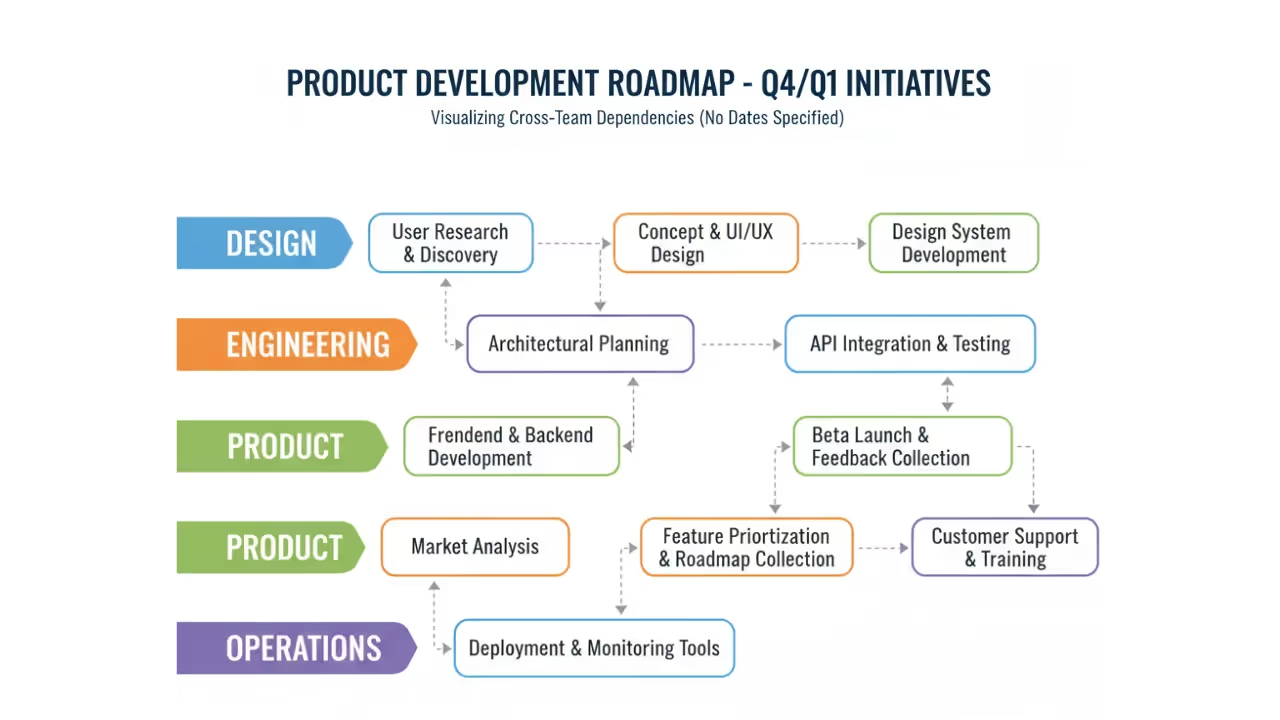
- Architecture view: Draw your current tech stack on the left and your future stack on the right. Use arrows to show migration paths and annotate milestones such as "move to microservices" or "adopt event‑driven architecture".
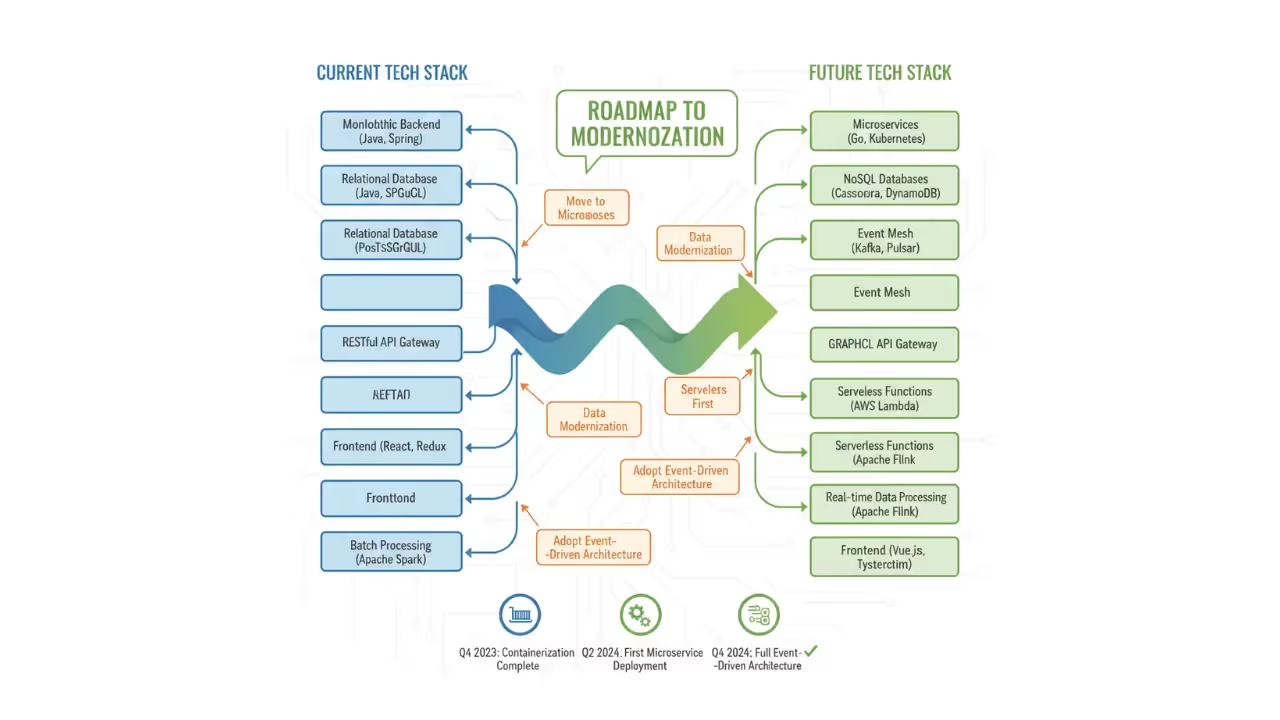
Mini case: Early‑stage SaaS startup
A year ago we worked with an early‑stage SaaS startup that had grown quickly. Their product team was shipping features but their infrastructure lagged. The founders asked us what is an IT roadmap because performance issues were slowing them down. We began by identifying their objectives: improve page load times, support a tenfold increase in users and prepare for compliance audits. We assessed their stack and found a monolithic backend with no automated testing. After interviewing stakeholders, we prioritised initiatives: migrating to a modular architecture, setting up continuous deployment, and investing in observability.
We mapped these initiatives over 18 months. In the first quarter we focused on automated tests and monitoring. In the second quarter we started breaking the monolith into services, and by the end of the year we had moved the database to a scalable platform. Alongside these technical changes we worked with the design team to ensure the user experience remained consistent. Regular reviews kept everyone on track. Within six months page load times dropped by 40 percent and the team could ship features weekly instead of monthly. This case shows that a roadmap does not need to be perfect on day one; iterative updates and collaboration yield results.
Conclusion
An IT roadmap is more than a pretty diagram. It is a working agreement that links technology work to what the business cares about. A clear roadmap helps early‑stage teams invest wisely, coordinate cross‑functionally and adapt as circumstances change. The research shows that technology transformation spending is growing rapidly and that most executives see it as a priority. Teams that plan carefully and monitor progress are better positioned to reap these investments.
If you’re a founder, product manager or design lead wondering what is an IT roadmap, the answer is simple: it is a living plan for your technology future. It should evolve with your strategy, involve everyone who relies on technology and provide clear signals about what matters most. Start by defining your goals, assess where you are, involve your stakeholders and build a plan that you update as you learn. It will not be perfect, but the act of creating and revisiting it will help your company make better technology decisions.
Frequently Asked Questions
1) What is meant by technology roadmap?
A technology roadmap is a planning tool that matches short‑term and long‑term goals with specific technology solutions. The Institute of Product Leadership describes it as a plan that aligns technology solutions with organisational goals and helps track development. Rather than prescribing exact tasks, it outlines major initiatives and timing.
2) What is the overview of technology roadmap?
An overview typically includes a vision, current state assessment, list of initiatives, milestones, dependencies, resources, metrics and governance. The purpose is to provide a high‑level view of how technology work supports business outcomes.
3) What does a roadmap include?
A roadmap includes objectives, a snapshot of current systems, a set of initiatives grouped by horizon (now, next, later), timelines or swimlanes, dependencies, budget and staffing needs, metrics and a governance model. It should be visual and easy to understand.
4) What is the difference between product roadmap and technology roadmap?
A product roadmap is an externally facing plan that communicates the vision and feature timeline for a product to customers and partners. A technology roadmap, on the other hand, is an internal document outlining the investments required to support business and product objectives.
5) How often should an IT roadmap be updated?
Review your roadmap at least quarterly. Factors such as market shifts, user feedback or unexpected technical issues may necessitate adjustments. The plan should be flexible so that you can re‑prioritise when needed.
6) What tools or software help build IT roadmaps?
Tools like roadmapping software, project management platforms and collaborative whiteboards can help. Many teams use spreadsheets or slide decks to get started. The most important factor is clarity; pick tools that your team understands.
7) How long is a typical planning horizon?
For early stage startups, 12–18 months is a practical horizon. Long‑term planning beyond two years becomes less reliable due to the pace of technology change. Use shorter horizons to drive focus and keep the roadmap relevant.
8) Why do startups ask what is an IT roadmap so often?
Because new ventures are resource‑constrained and must make strategic trade‑offs, they frequently revisit what is an IT roadmap. The phrase surfaces in conversations when founders realise they need a coherent plan to justify spending on infrastructure, security or design improvements. A clear answer helps them communicate priorities to investors and team members alike.

.avif)











